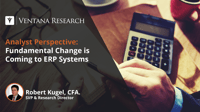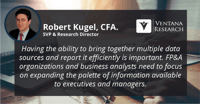Can you imagine a more arcane and boring topic than accounts receivable? Unless you are the CFO, controller, chief accounting officer or treasurer of an organization, maybe not. Anecdotally, as it’s part of the trend to the digital transformation of all things in the department, there appears to be greater interest in this area of the Office of Finance. With populations locked down and the accounting staff unable to work in an office, the need to operate virtually has accelerated the...
Read More
Topics:
Office of Finance,
Financial Performance Management,
ERP and Continuous Accounting,
robotic finance,
AI and Machine Learning
Enterprise resource planning (ERP) systems are central to nearly every organization’s management of operational and financial business processes. They are essential to the smooth functioning of an organization’s record keeping, accounting and finance tasks. In manufacturing and distribution, ERP manages inventory and logistics. Some ERP software vendors incorporate an extended set of capabilities that include managing human resources as well as supply chains and logistics. In the 2020s,...
Read More
Topics:
Office of Finance,
Financial Performance Management,
ERP and Continuous Accounting,
robotic finance,
Predictive Planning,
AI and Machine Learning
The annual Ventana Research Digital Innovation Awards showcases advances in the productivity and potential of business applications, as well as technology that contributes significantly to improved efficiency and productivity in the processes and the performance of an organization. Our goal is to recognize technology and vendors that have introduced noteworthy digital innovations that advance business and IT.
Read More
Topics:
Customer Experience,
Human Capital Management,
Office of Finance,
Contact Center,
Workforce Management,
Digital Technology,
Operations & Supply Chain,
Enterprise Resource Planning,
ERP and Continuous Accounting,
robotic finance,
employee experience,
continuous supply chain,
agent management,
work experience management
The last decade has seen exponential growth amongst subscription-based business models. Pioneered in the B2C market with cloud-based SaaS offerings, the last decade has seen exponential growth in the share of the economy that is now subscription based. Increasingly, this modern business model is permeating throughout more traditional style industries and companies. But regardless of whether a company is natively subscription based, or is transitioning, maintaining this growth requires...
Read More
Topics:
Sales,
Customer Experience,
Office of Finance,
Voice of the Customer,
embedded analytics,
Analytics,
Business Intelligence,
Collaboration,
Internet of Things,
Contact Center,
Product Information Management,
Price and Revenue Management,
Digital Commerce,
Enterprise Resource Planning,
ERP and Continuous Accounting,
natural language processing,
robotic finance,
revenue and lease accounting,
Subscription Management,
agent management,
intelligent sales,
sales enablement,
AI and Machine Learning
Subscription-based business models have seen exponential growth over the last decade. The growth of this recurring revenue business model, where a subscriber commits to repeatedly pay for a good or device for a fixed or indefinite timeline, has been caused by the shift from the one-time selling of physical products to selling digital services on a subscription basis. The first phase of this transformation was led by “digitally native” organizations, typically B2C, that have only ever offered...
Read More
Topics:
Sales,
Customer Experience,
Office of Finance,
Voice of the Customer,
embedded analytics,
Analytics,
Business Intelligence,
Collaboration,
Internet of Things,
Contact Center,
Product Information Management,
Price and Revenue Management,
Digital Commerce,
Enterprise Resource Planning,
ERP and Continuous Accounting,
natural language processing,
robotic finance,
revenue and lease accounting,
Subscription Management,
agent management,
intelligent sales,
sales enablement,
AI and Machine Learning
One of the challenges of being a practically minded technology analyst is squaring the importance of “the next big thing” with the reality of what most organizations are doing. For decades it’s been the case that “the next big thing” in the world of information technology is easily several years ahead of where most organizations are in their use of technology. And before most organizations can realize the benefit of some whiz-bang technology, they frequently need to address a range of more...
Read More
Topics:
Human Capital Management,
Marketing,
Office of Finance,
Analytics,
Business Intelligence,
Sales Performance Management,
Financial Performance Management,
Price and Revenue Management,
Digital Marketing,
Work and Resource Management,
Digital Commerce,
Operations & Supply Chain,
Enterprise Resource Planning,
ERP and Continuous Accounting,
robotic finance,
Predictive Planning,
revenue and lease accounting,
Subscription Management,
intelligent sales,
AI and Machine Learning
Business planning is an essential part of an organization’s focus on its future performance and overall potential because it ensures continuous operations, even in black-swan events. Planning across the entire organization needs to be a critical priority and leadership should give it the attention it deserves. In challenging times, a focus on execution tends to take hold — this is not unreasonable but in focusing on satisfying immediate customer and workforce needs and putting out fires,...
Read More
Topics:
Sales,
Human Capital Management,
Office of Finance,
Continuous Planning,
Analytics,
Business Intelligence,
Collaboration,
Internet of Things,
Data,
Sales Performance Management,
Workforce Management,
Financial Performance Management,
Price and Revenue Management,
Operations & Supply Chain,
Enterprise Resource Planning,
ERP and Continuous Accounting,
Total Compensation Management,
Predictive Planning,
Conversational Computing
Workiva recently introduced Chains, a visual workflow tool for the Workiva platform. Individuals use Chains to create and manage linear sequences of tasks that they otherwise would have to execute manually, for example, automatically updating a report with the most current dataset. Chains is like old-style Excel macros in its simplicity; users configure sequences with a drag-and-drop visual interface. There’s nothing to code and it’s easy to follow the sequence and the logic that drives the...
Read More
Topics:
Office of Finance,
Financial Performance Management,
ERP and Continuous Accounting,
Reporting, XBRL, iXBRL, document management
Recent events are forcing corporations to adopt dedicated software for tax provision, transfer pricing and tax analysis. The fiscal damage that the global pandemic is inflicting on countries is likely to result in a more aggressive tax enforcement environment. This will further pressure organizations to establish centralized control and oversight in managing income taxes in corporations. This will also require visibility into tax processes by senior executives, especially for the CFO. Dedicated...
Read More
Topics:
Office of Finance,
Financial Performance Management,
ERP and Continuous Accounting,
tax; tax provision; transfer pricing
In a recent note on virtualizing the close, I observed that finance and accounting organizations that can operate in a virtual mode are better able to adapt to changing circumstances and overcome obstacles. Having systems that people can readily access remotely to collaborate and execute processes virtually makes it easier for departments to meet their commitments with confidence. The core technology underpinning the ability to work in a virtual mode is the cloud. That’s because the cloud...
Read More
Topics:
Office of Finance,
Financial Performance Management,
ERP and Continuous Accounting,
Predictive Planning



















